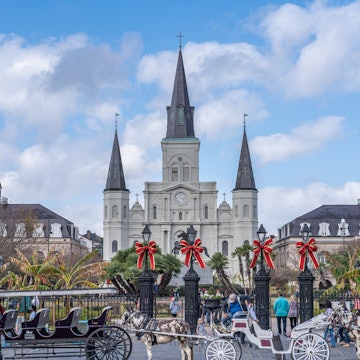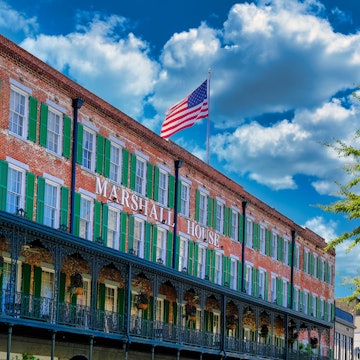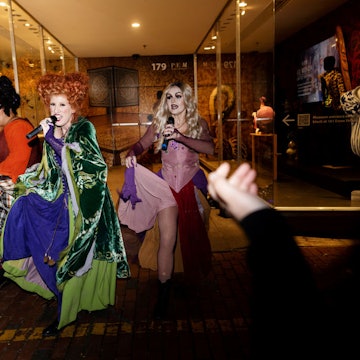

Charlie Gabriel performing at the Fairgrounds Race Track in New Orleans. Adam McCullough/Shutterstock
New Orleans is a delight to the senses: delicious food that's a taste sensation, visually spectacular architecture, and perhaps most iconically, sonically enriching music.
You can enjoy live music every night of the year here, and the proof of this superb state of affairs is the Livewire, a comprehensive clearinghouse of music around town maintained by local radio station WWOZ, itself dedicated to the sounds of the city. How many other cities with a population this size (357,500) have radio stations dedicated to their homegrown music scene, as well as books, movies and TV shows?
Why is music so important to New Orleans?
Because music was one of the central ways early New Orleanians countered oppression with expression. French colonizers permitted enslaved African people a day of rest, once a week. During this time, the enslaved people assembled in Congo Square, located in the modern Treme, and were able to reconnect to the language and rhythms of the African continent. Those who gathered in the Square were eventually joined by the Free People of Color – free black or mixed citizens, at the time a rarity in the rest of the country, but fairly common here.
The Free People often had education in classical instruments like the violin and piano. When American marching bands came through town during the Civil War, the combination of classical instrumental talent and African-originated rhythms, along with access to brass instruments, gave rise to jazz. This music was initially played in local bars and brothels, and from there it spread to the rest of the country. Jazz, in turn, has incubated all of the New Orleans music that has come since, and arguably American pop music as a whole, demonstrating that histories of pain and displacement can be transmuted into beauty and art – a lesson that is, quintessentially, New Orleanian.

What music are people listening to?
If we’re talking about the sounds of native soil, the particular music New Orleans has fostered is obviously jazz and all its derivatives. Brass band music is integral to second lines, urban parades organized by Social Aid & Pleasure Clubs, which have long been a cornerstone of the African American community. If you want to join a second line, and we think you should, everything you need to know is right here.
Hip-hop is huge, with bounce being the preferred sonic vehicle for millennials on up (the Gen Z crowd opts more for trap and associated genres). Bounce is a homebrewed version of hip-hop, known for its hyper-quick "triggerman" backbeat and twerking on the dancefloor, invented in New Orleans by (arguably) TT Tucker and DJ Irv with 1991’s Where Dey At, or alternatively, DJ Jubilee in 1993.
With all of that said, one can find any kind of music in New Orleans. At a bar like BJ’s in the Bywater, you can hear Cajun electronica via Louis Michot, or roots folk with Sam Doores – Swifties go wild for Taylor here, the same as they do across the world. Heavy metal and punk hit the stage at the Goat and Siberia, and there’s even a band out here dedicated to sea shanties: the chanting, stomping small army of sweat-fueled harmonic bellowing that is the Valparaiso Men’s Chorus.

Where should I listen to music?
You can always just wander up Frenchmen Street any night of the year. Music will be playing, crowds will be jostling, and drinks will be flowing. Walk by an open door with open ears; if what you hear sounds good, by all means, head in.
Tipitina’s: New Orleans is a great music town, but it’s a town of smaller venues. Tips, as it is commonly known, is the most storied midsize venue in the city, named for a ballad by Professor Longhair that blends baby babble and a birdsong-adjacent piano riff. Tipitina’s used to be a gym, then a brothel before it became a concert hall; WWOZ used to record shows here by hanging a mic through a hole in the ceiling. It’s crowded, it’s historical, and inevitably, it will give you one of those nights you’ll remember fondly in your old age.
The Saturn Bar: If the Spotted Cat can look structurally unsound, the Saturn Bar looks like a house of cards in a stiff breeze. Huddled on St Claude Avenue, which has long been a sort of fencepost for downtown gentrification, the Saturn somehow only gets more chaotic on the inside. Old stairs lead to a balcony that sways with the crowds, who regularly groove to a mix of genres running from punk to funk to cumbia to hip-hop.
Vaughan’s: Another member of the “This roof is about to collapse, right?” school of New Orleans small venue design, Vaughan’s is a neighborhood bar in the Bywater. We need to stress: this place isn’t just a neighborhood bar. It’s on a residential block that's filled with families who come out for a cold beer and a night listening to local legends (primarily brass bands) who absolutely tear it up on Thursday nights. Dancing on the wooden floor of Vaughan’s at an entirely ill-advised hour should very much be on your bucket list.

The Spotted Cat: A pack of tourists surges towards the bar in search of a cold drink, jostling locals and upping the tension that can grow in a place where bodies and beer are in close proximity. Yet even as this is happening, the musicians take the stage, and everyone starts to smile. Minutes later some kind of sweet, sweaty jazz breaks over the audience like a warm wave, and everyone is dancing, strangers no more. Located near the top of Frenchmen, the Cat is a sweatbox, small and by all appearances structurally unsound, yet it is also a quintessential New Orleans jazz bar; don’t miss it.
The Maple Leaf: Now take your attention Uptown, a few blocks off Carrollton Ave, nestled in one of those green and leafy New Orleans neighborhoods that looks like the sort of town fantasy elves would build if the only local trees were live oaks. The Maple Leaf is old (50 years) and funky; your parents danced here, and maybe their parents too, and now it's your turn to hit this spot up for brass music, funk and some Jon Cleary.
Chickie Wah Wah: Here’s another spot named after an R&B classic, and it delivers much the same experience as Tipitina’s, just cozier. Chickie Wah Wah is simply a joy, a small venue where some of the city’s best musicians have gotten their start. The calendar is admirably packed, and well-curated; you basically can’t go wrong showing up here.
Broadside: The pandemic took away many New Orleans blue chip businesses, but it did give the city its newest, community-minded outdoor venue: the Broadside. Attached to a local indie movie theater, the Broadside has managed, in just a few years, to become an indispensable venue, hosting all manner of local music royalty in a space that makes room for food trucks and an excellent bar.

When is a good time to come for music?
Summer is always slow in New Orleans, besides being almost unbearably hot, but you’ve got a decent chance of having some venues almost to yourself if that’s your thing. For the opposite experience, many bands flock to town during festival season, which runs from the end of Mardi Gras until mid-May.
The New Orleans Jazz & Heritage Festival – better known as Jazz Fest – is the capstone of these music festivals, but don’t sleep on the French Quarter Festival, which is entirely free. The November and December shoulder season can be a great time for music – there are fewer tourists, the weather has cooled off, and New Orleans looks real pretty decked out in Christmas lights.
Outside of festival season, the standard cover at most New Orleans music spots is $5-15. Near Mardi Gras and Jazz Fest, you’ll probably get charged at least $20.
















